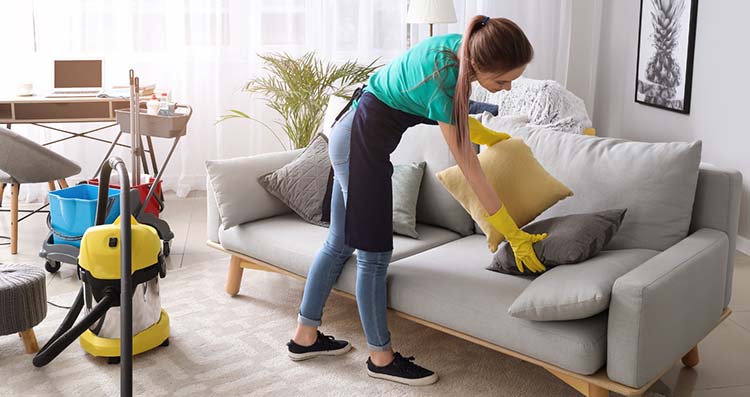How useful is medical monitoring for employees in service voucher organisations?
In 2022, the Occupational Welfare Supervision Inspectorate took a close look at the service voucher sector. As many as 1,172 infringements were recorded. The Labour Inspectorate is therefore pushing for mandatory periodic medical monitoring for domestic workers. Karine Eerdekens, Director of Risk Management at Mensura, and An De Roeck, Director of Medical Monitoring, weigh the pros and cons.
Domestic workers are exposed to specific hazards and risks, including exposure to chemicals, lifting of loads, and repetitive movements. Since they work in private homes, it is difficult for employers and prevention services to have a picture of the concrete hazards and risks for each work situation. Monitoring the correct application of work instructions is also far from evident.
Last year’s 175 inspection visits are currently raising a lot of eyebrows. They resulted in 159 written warnings, 19 written opinions, and 1 official report.
The top three findings:
- the absence of written risk assessments;
- the lack of appropriate medical monitoring;
- the lack of supervision by the employer at the user’s home to check whether the work equipment and maintenance products used have an impact on the safety and health of the domestic worker.
In other words, too often there is still little or no visibility of the potential health risks for domestic workers, nor monitoring of the impact on their health.

Based on the findings, the Inspectorate recommends inviting employees of service voucher organisations for periodic medical monitoring more often. But is this a good thing?
An De Roeck: “Is this the right solution to the problem that’s been identified? Service voucher employees are among the top in terms of reports of occupational illnesses. This occupational category is also strongly represented among the long-term absence due to illness.
With this observation, one could conclude that more frequent medical monitoring is useful and necessary. But that’s not true. Figures from 2013-2016 – a period when service cheque employees typically still received an annual health check – show a similar picture in terms of occupational illness and long-term absence. More medical monitoring seems thus not an evidence-based measure to solve the problem.
And that’s logical. We can detect if someone is developing health problems (early on) through medical monitoring. At the same time, we can raise the concerned employee’s awareness. But if they have to return to work in a suboptimal working environment afterwards, their health will only deteriorate further.”
Karine Eerdekens: “Last but not least, it is a misconception that an occupational disease can only be notified if it was preceded by a periodic examination. This isn’t the case! It is sufficient that a hazard or risk is attributed to the job to report an occupational illness.
And even that is not strictly necessary. Even employees who are not required to undergo periodic medical check-ups because of their professional activity find their way to the occupational doctor and report it. That never caused problems in recognition as an occupational illness.”

So, is there a better alternative?
Karine Eerdekens: “Definitely. Mensura is convinced that focusing on prevention can and will lead to results. And no, the inspection results do not contradict that. To get noticeable results, each player has to do their part: employers, internal and external prevention services, employees, and clients of the service voucher organisation.
As an external service, we can start from a generic risk analysis for each welfare domain. Conducting a risk analysis for every individual is not realistic, and it’s also unnecessary. Indeed, the risks in this sector are well known and documented.
Prevention measures can be drawn up based on those generic analyses. What cleaning equipment must the client provide? Which cleaning products are desirable and which ones are forbidden? What tasks must a domestic worker not perform? What personal protective equipment must those workers wear? What training and instruction must they receive? And so forth.”
The employment is outside the daily supervision of the employer. So how can we ensure that these measures are followed?
Karine Eerdekens: “There is simply no such thing as zero risk. But it is true that in this work setting, assurance is not evident. A few interventions will get us a long way. For instance, based on the risk analysis, a checklist can be drawn up by the internal or external service, which can be useful when interviewing a new client. A classic example: a steep, dark staircase to the basement. An instruction here could be to fit the stairs with a better handrail and lighting. Or include a ban on the cleaning lady going to the basement. We have been applying that system to service voucher organisations for many years.
To further respect the agreements made in the coming months and years, a number of service voucher organisations are already working with internal coaches now. These are employees who are trained to recognise risks, know the instructions well, and are trained to steer colleagues and clients where necessary. If older workers can be trained for this, then you are also fulfilling CLA 104 as an employer, which stipulates that you give older workers who are starting to struggle a bit less heavy work.”
An De Roeck: “And let’s not forget good training for domestic workers. Not just on the technical aspects of their job but also on how to correctly decline when a client does ask them to do things that their instructions do not allow them to do.
Each stakeholder in this story has their role to play, as Karine rightly points out. And let’s certainly not forget the government here. A possible measure from that angle could be to make targeted visits to service voucher organisations that deploy coaches, for example, and on the basis of numerical analyses, substantiate whether or not this is now recommended as a best practice for each player.
As a service voucher organisation, you could also indicate to the clients what materials and products must be present for the domestic worker. This way, they are already letting their clients know about the proper work tools that are needed and basic working conditions can start to improve already.”
